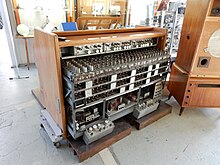EKI 1
The Toccata organ EKI 1 is an electronic organ that was developed and built in 1954 by the Telecommunications Plant in Berlin-Oberschöneweide , which later became the television electronics plant .
The organ consists of over 250 electron tubes and various other components. The organ was the first tube organ in the world and is of great importance for the development of electronic musical instruments. It mimics the sound of a pipe organ very precisely, including the swing in and swing out . Investigations of Silbermann organs were incorporated into the development . Special tone generator circuits and frequency dividers were used for the sound generation. The sound was shaped by complex filter systems.
The GDR hoped that the development of electronic organs would bring foreign currency businesses. The organ was also intended for recording film music and for use in cinemas and cultural centers. These expectations were not fulfilled, however, because, on the one hand, the production was very expensive and, on the other hand, at the time of development there were fundamental political reservations about the organ, which is mostly used in churches. The development was therefore stopped. A total of four EKI 1 were produced, one of which has been preserved. This instrument was in use at the Komische Oper Berlin from 1961 to 1989 . Since 2009 it has been located in the Schöneweide industrial salon , which u. a. exhibits the holdings of the former WF Museum. The organ is playable.
Web links
- Podcast about EK 1 , accessed on April 12, 2018.
Individual evidence
- ↑ Information on industriesalon.de, accessed on January 26, 2017
- ↑ Opening report on industriesalon.de, accessed on January 26, 2017
source
- Information board in the Schöneweide industrial salon, September 2015

